Acton
OS Grid ref:-
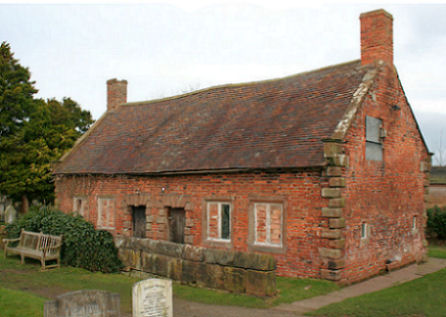 The village of Acton lies to the west of Nantwich.
The village of Acton lies to the west of Nantwich.
The village lay on the eastern edge of the great Forest of Mondrem in early medieval times, in the eleventh century the twin forests of Mara and Mondrum extended to over 60 square miles, today's Delamere Forest is the last surviving remnant of them. The name Acton derives from Actune, meaning "oak town".
Acton is mentioned in the Domesday Book of 1086, when it was held by Earl Morcar before the Conquest and afterwards by William Malbank, first baron of Wich Malbank.
During the Civil War, Acton village was taken by siege several times. The Battle of Nantwich of 1644 took place adjacent to the village. The Royalists under Lord John Byron were besieging nearby Nantwich, and Sir Thomas Fairfax led an army to relieve the town. The village church of St. Mary's served as the Royalist headquarters at the time and visitors can still see evidence of the battle in the form of musket shots which are clearly visible in the south transept of the building.
The centre of the village has been designated a conservation area. Historic buildings to be found in Acton include two grade-II-listed brick almshouses (pictured above) which stand in the churchyard they were built in 1613 by Sir Roger Wilbraham. a prominent English lawyer who served as Solicitor-General for Ireland under Elizabeth I and held positions at court under James I.
The half timbered village pub, the Star Inn was built in the late seventeenth century, the Glebe House, situated on Monks Lane, was once the vicarage and dates back to 1723.
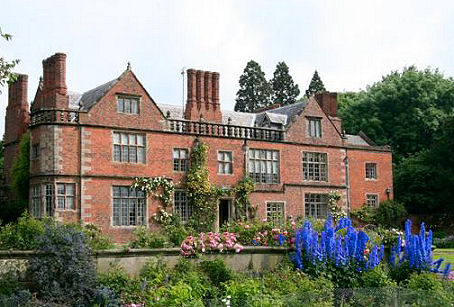 A moated enclosure (OS grid ref- SJ62925315) lies just outside Acton village, to the west of the church; it is a Scheduled Ancient Monument. It is thought to be the site of a medieval vicarage, consisting of a square moat surrounding a raised island, and is the only local example to be filled with water.
A moated enclosure (OS grid ref- SJ62925315) lies just outside Acton village, to the west of the church; it is a Scheduled Ancient Monument. It is thought to be the site of a medieval vicarage, consisting of a square moat surrounding a raised island, and is the only local example to be filled with water.
Dorfold Hall,(pictured right)is grade I listed Jacobean mansion. The present red brick hall is thought to occupy the site of a house owned by Edwin, the Saxon Earl of Mercia, elder brother of Earl Morcar and brother-in-law to King Harold II, England's last Saxon king, which was at a place then called Darford or Durfold. Although it does not appear in the Domesday survey, a manor at Dorfold is recorded during the reign of King Henry III (1216-72).
The Dorfold estate was purchased in 1602 by Sir Roger Wilbraham. The impressive building we see today was constructed in 1616-21 for his Roger Wilbraham's younger brother and heir, Ralph. His son, Richard, was a Parliamentarian and in 1643 Dorfold Hall was plundered by the Royalist forces. In 1754 the property was purchased by James Tomkinson, a Nantwich lawyer, who commissioned Samuel Wyatt to redecorate the ground floor. In the late 18th century the house became an important hunting centre and the Tomkinson family added extra stables to the property. In 1892 Wilbraham Spencer Tollemache, who married Ann Tomkinson, made several additions to the house. He also engaged W. A. Nesfield to redesign the park and gardens, including the planting of a marvellous avenue of lime trees. Dorfold Hall Park now plays host to the annual Nantwich and South Cheshire Show which hosts Europe’s largest international cheese exhibition amongst many other rural attractions.
The hall's 18 acres of gardens reflect four centuries of gardening styles. To the south of the Hall, the spring bulbs and herbaceous borders provide colour throughout the spring and summer. Visitors can also enjoy the fine specimen trees, a woodland and stream dell and a rock garden containing rhododendrons, azaleas, magnolias and acres.
St Mary's Church
Acton's village church, St. Mary's, dates from the thirteenth century, possibly earlier, the tower is believed by some authorities to be the oldest in Cheshire, it has a Norman foundation but the upper sections were Early English. In 1757 a violent storm caused the collapse of the upper part of the tower, which was rebuilt to 84 feet (it was originallly 100 feet).
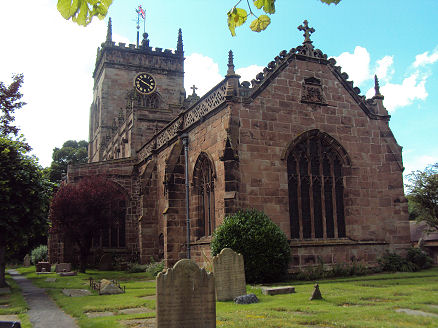
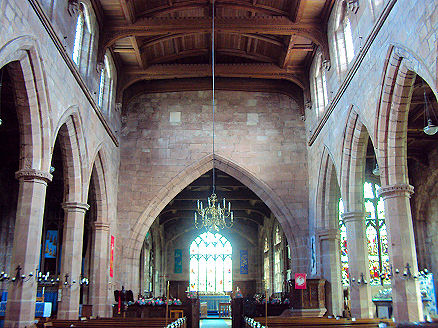
Evidence of an earlier, Saxon church is suggested by Saxon carved stones incorporated into its foundations. In the early twelfth century Acton church and the surrounding lands were given by the second Baron of Wich Malbank to the monks of Combermere Abbey, who retained ownership until the Dissolution of the Monasteries. The church has been expanded and altered over the centuries and there is evidence of 13th and 14th century building. There have also been three significant restorations.
The church font dates back to Norman times, this was discovered at a local farm in 1820. Further interesting features within the building include aa medieval stone bench around the walls- origin of the expression "the weak go to the wall", some Anglo-Saxon stones discovered during an 1897 restoration, as well as Victorian stained glass by Charles Kempe.
Anglo-Saxon stones discovered during the 1897 restoration of the church
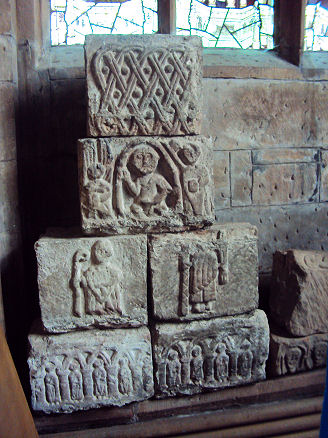
The Mainwaring Chapel contains a sandstone and alabaster effigy of Sir William Mainwaring of Baddiley and Peover, who died in the Crusades in 1399 and is said to have endowed Acton with a piece of the true cross. His allegiance to the house of Lancaster is displayed by his chain with the S motif for Spirtus Sanctus. There is also a monument to Sir Richard Wilbraham (1578-1643) of Woodhey Hall and his wife. Sir Richard was responsible for the restoration of 1620 and died during the Civil War.
Medieval Effigy of Sir William Mainwaring and Sir Richard Wilbraham and his wife, which dates from the Civil War period
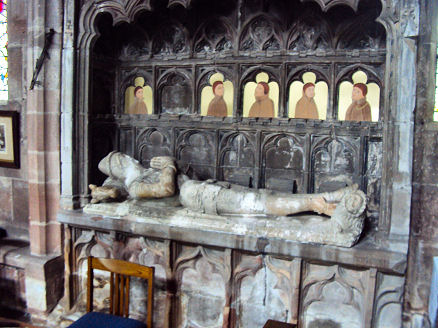
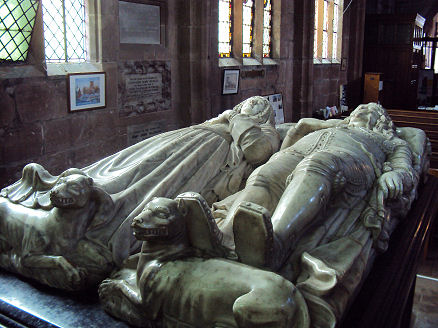
The sundial which stands in the churchyard dates from the late seventeenth century. It measures twelve feet in height and is of unusual shape, having a long octagonal shaft topped with a ball finial, the sundial is believed to have originated as a medieval cross, perhaps destroyed by Puritans.
Nearby places of interest
Cheshire Animal Farm, at Acton Bridge, home to a variety of animals, many of which are rescued for a second chance in life.
Bridgemere Garden World, covering fifty acres and Britain's largest garden centre, is located south of Nantwich and lies on the borders of Cheshire, Staffordshire and Shropshire. A gardener's paradise, the centre makes a great day out for the enthusiast.
The Anderton Boat Lift, the world's first and England's only boat lift. Dating from 1875, the Anderton Boat Lift is one of the greatest monuments to Britain's canal age and known as the "Cathedral of the Canals". It provides a fifty foot vertical link between two navigable waterways: the River Weaver and the Trent and Mersey Canal.
